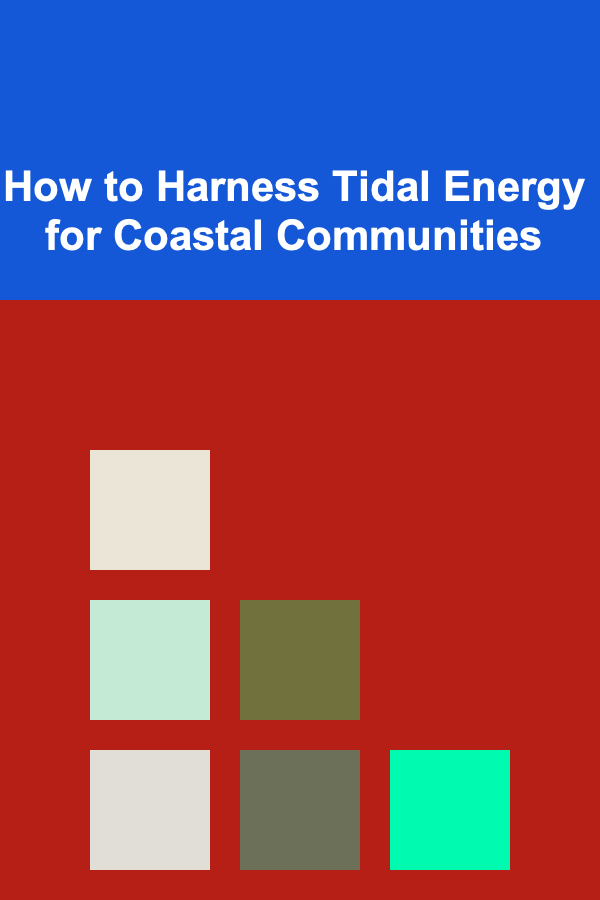
How to Harness Tidal Energy for Coastal Communities
ebook include PDF & Audio bundle (Micro Guide)
$12.99$8.99
Limited Time Offer! Order within the next:

Tidal energy, a form of renewable energy that is generated from the rise and fall of tides, offers a significant opportunity for coastal communities to develop sustainable, reliable power sources. Unlike other renewable energy sources such as wind and solar, tidal energy provides a predictable and consistent energy supply because tides are influenced by the gravitational pull of the moon and the sun. This reliability makes it a valuable option for regions dependent on local energy sources, especially those situated near the coast.
In this article, we will explore the different methods for harnessing tidal energy, the potential benefits and challenges it presents to coastal communities, and how such technology can play a transformative role in shaping the future of sustainable energy.
Understanding Tidal Energy
Tidal energy is created by the movement of water due to the gravitational forces exerted by the moon and the sun on the Earth. As water moves in and out of coastal areas, it creates what is known as tidal streams or currents. These currents can be harnessed using various technologies to generate electricity.
Tidal energy systems can be classified into two main types:
- Tidal stream systems: These systems use the movement of water to turn turbines, much like underwater wind turbines. The kinetic energy of the tidal currents is converted into mechanical energy, which can then be transformed into electricity.
- Tidal range systems: These systems take advantage of the difference in water levels between high and low tides. By building a dam or barrage across an estuary or bay, the potential energy created by the difference in water levels can be captured as the tide comes in and goes out. This type of system is less common than tidal stream systems but is still a viable option in certain locations.
The key advantage of tidal energy is its predictability. Unlike solar and wind energy, which depend on weather conditions and sunlight hours, tidal energy is constant and can be accurately forecasted, offering coastal communities a stable source of power.
How Tidal Energy Works
Tidal energy technology can be broken down into three primary systems: tidal stream generators, tidal barrages, and tidal lagoons. Each of these methods has its own advantages and drawbacks depending on the specific needs of the coastal community.
Tidal Stream Generators
Tidal stream generators are essentially underwater turbines placed in tidal currents. These turbines function similarly to wind turbines, except they are submerged in the water. As the tide flows in and out, the water movement turns the blades of the turbine, generating electricity. The technology behind tidal stream generators is well-developed and has seen significant advancements in recent years.
These systems can be installed in both deep and shallow water and are often placed in areas where tidal currents are strong, such as straits or narrow channels. The energy generated can be transmitted to land via subsea cables, making it possible to deliver power to coastal communities.
One of the key advantages of tidal stream generators is their minimal environmental impact. Unlike tidal barrages, which can disrupt local ecosystems, tidal stream systems have less interaction with the surrounding environment. Furthermore, these systems are scalable, meaning they can be installed in stages as demand for power increases.
Tidal Barrages
Tidal barrages are large structures built across the mouth of an estuary or bay. These structures are designed to capture the difference in water levels between high and low tide. When the tide comes in, water is trapped behind the barrage, and when the tide goes out, the stored water is released through turbines, generating electricity.
Tidal barrages are more efficient in areas with significant tidal ranges (the difference between high and low tide). They are capable of producing large amounts of energy, making them suitable for providing power to large communities or even for export to other regions. However, tidal barrages have a significant environmental impact as they can alter local ecosystems, affect fish migration patterns, and change the salinity of the water.
Despite these challenges, tidal barrages have been successfully implemented in several locations worldwide, including the La Rance Tidal Power Station in France, which has been in operation since 1966. The technology is continuously evolving, and researchers are working to develop more environmentally friendly designs that can mitigate the impacts on local ecosystems.
Tidal Lagoons
Tidal lagoons are artificial bodies of water created by building a barrier around a coastal area. Like tidal barrages, tidal lagoons use the difference in water levels between high and low tide to generate power. However, instead of building a large structure across the mouth of an estuary, tidal lagoons are typically built in areas where the topography is suitable for creating a closed-off basin. The stored water in the lagoon is released through turbines, generating electricity.
Tidal lagoons are often considered a more environmentally friendly option compared to tidal barrages, as they are typically built further from shore and have less impact on marine ecosystems. The Swansea Bay Tidal Lagoon in the United Kingdom is one of the most well-known projects in this category, and while it has faced political and financial challenges, it offers a glimpse into the potential for large-scale tidal lagoon development.
Benefits of Tidal Energy for Coastal Communities
Tidal energy presents a wide range of benefits to coastal communities, particularly in terms of energy security, environmental sustainability, and economic development.
Energy Security and Reliability
Tidal energy offers coastal communities a reliable and predictable source of energy. Unlike solar and wind power, which depend on fluctuating weather conditions, tidal energy is driven by the consistent movement of the moon and the sun. This predictability makes tidal energy an excellent complement to other renewable energy sources, ensuring a steady supply of electricity, even when other sources are intermittent.
In addition, tidal energy systems can operate for many years with minimal maintenance, making them an attractive option for communities seeking long-term energy solutions. By harnessing tidal power, coastal communities can reduce their dependence on imported fossil fuels and increase their energy independence.
Environmental Sustainability
One of the most compelling reasons for harnessing tidal energy is its environmental sustainability. Tidal energy is a clean, renewable resource that produces no greenhouse gas emissions during operation. Unlike fossil fuel power plants, tidal energy systems do not release harmful pollutants into the atmosphere or oceans.
Additionally, tidal energy is more reliable and predictable than other forms of renewable energy, such as wind or solar, which are subject to seasonal variations. This predictability makes it easier to integrate tidal power into existing energy grids, reducing the need for fossil-fuel-powered backup systems.
While there are some environmental concerns associated with tidal energy systems, such as the potential disruption of marine life and ecosystems, these impacts can often be mitigated through careful planning and the use of environmentally friendly technologies.
Economic Development and Job Creation
Tidal energy has the potential to provide significant economic benefits to coastal communities. The construction and maintenance of tidal energy systems can create a range of jobs, from engineers and technicians to construction workers and maintenance personnel. Furthermore, the development of tidal energy infrastructure can stimulate local economies by attracting investment and fostering innovation in clean energy technologies.
Coastal communities can also benefit from the potential export of excess tidal energy to neighboring regions or countries. By establishing themselves as leaders in tidal energy production, coastal areas can position themselves as key players in the global renewable energy market.
Challenges and Considerations
While tidal energy offers many benefits, there are also several challenges and considerations that must be addressed to ensure its successful implementation in coastal communities.
Environmental Impact
As mentioned earlier, tidal energy systems can have environmental consequences, especially when it comes to tidal barrages and lagoons. These systems can alter local ecosystems, affect fish migration patterns, and change water quality. Ensuring that tidal energy systems are developed in an environmentally responsible manner is critical to minimizing these impacts.
High Initial Costs
The initial costs of building tidal energy systems can be quite high, particularly for tidal barrages and lagoons, which require significant infrastructure investments. While the long-term benefits of tidal energy can offset these costs, securing financing for such large projects can be a major challenge.
Technological Challenges
Although tidal energy technology has made significant advances in recent years, there are still several technical hurdles to overcome. For example, tidal turbines must be designed to withstand harsh marine environments, and the installation of underwater turbines requires specialized equipment and expertise. Furthermore, the integration of tidal energy into existing power grids can be complex, especially in regions where energy infrastructure is outdated or underdeveloped.
The Future of Tidal Energy
The future of tidal energy looks promising, with several large-scale projects currently under development around the world. As technology advances and costs decrease, tidal energy is expected to play a growing role in the global energy mix.
Coastal communities, in particular, stand to benefit from the development of tidal energy, as it offers a reliable, environmentally friendly, and economically viable source of power. By investing in tidal energy infrastructure, coastal regions can secure their energy future while also contributing to the global transition to renewable energy.
In conclusion, tidal energy has the potential to revolutionize the way coastal communities generate and consume energy. By harnessing the power of the tides, these communities can reduce their reliance on fossil fuels, create jobs, and contribute to a cleaner, more sustainable world. While challenges remain, the continued development of tidal energy technology offers a promising pathway toward a sustainable energy future.
Reading More From Our Other Websites
- [Home Space Saving 101] How to Use Storage Ottomans to Free Up Room in Your Living Area
- [Home Cleaning 101] How to Clean Your Home Without Using Disposable Products
- [Home Storage Solution 101] How to Store Your Luggage and Travel Gear Efficiently
- [Home Storage Solution 101] How to Organize Your Jewelry Collection with Clever Storage Ideas
- [Hiking with Kids Tip 101] From Playground to Mountain: Kid‑Friendly Hiking Shoes That Deliver Performance
- [Personal Financial Planning 101] How to Adjust Your Investment Strategy Based on Your Latest Risk Tolerance Assessment
- [Personal Care Tips 101] How to Choose a Facial Scrub for Dry Skin in Winter
- [Personal Financial Planning 101] How to Set Financial Goals and Achieve Them Step by Step
- [Beachcombing Tip 101] Seaside Treasures: 10 Fun Beachcombing Activities for Kids
- [Soap Making Tip 101] Best Sustainable Packaging Ideas for Handmade Soap Entrepreneurs

How to Create a Minimalist Living Room That Saves Space
Read More
How To Prepare for Managerial Interviews
Read More
How to Understand the Science of Beer Carbonation
Read More
The Importance of Paying Bills on Time to Avoid Late Fees and Penalties
Read More
Why It's Important to Have a Dedicated Space for Hobbies
Read More
How to Manage Digital Nomad Loneliness Proactively
Read MoreOther Products

How to Create a Minimalist Living Room That Saves Space
Read More
How To Prepare for Managerial Interviews
Read More
How to Understand the Science of Beer Carbonation
Read More
The Importance of Paying Bills on Time to Avoid Late Fees and Penalties
Read More
Why It's Important to Have a Dedicated Space for Hobbies
Read More